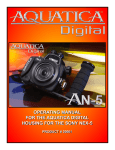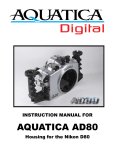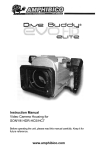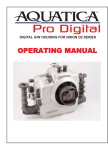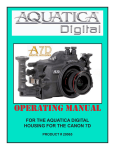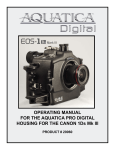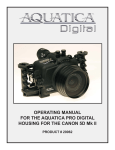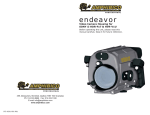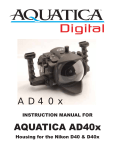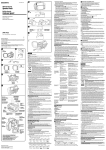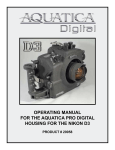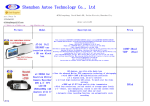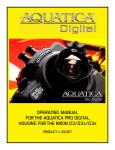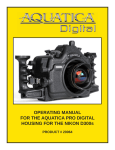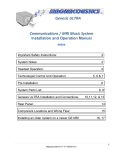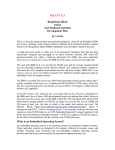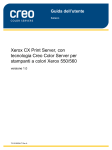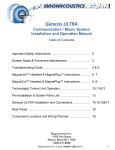Download AMPHIBICO Video Camera Housing Instruction manual
Transcript
AMPHIBICO WAVE HOUSING OPERATING MANUAL (FOR THE FOR THE SONY HDR-CX560 & CX700 CAMCORDERS) PRODUCT # WAVH0560 FOREWORD FOREWORD Thank you for having selected the AMPHIBICO Digital HD Video Housing System for your underwater videography. The AMPHIBICO Digital HD Video Housing is the result of a long and continuing relationship with the most demanding underwa¬ter videographers in the world. Each housing is handcrafted, quality checked and pressure tested to a 300 feet equivalent by a small group of specially trained individuals, each of whom takes the utmost pride and satisfaction in offering the best underwater video housing in the world. The AMPHIBICO Digital HD Video Housing was designed for optimum technical and optical performance and to provide easy and efficient underwater access to essential functions and controls of the Sony CX560V/CX700 camcorders.This manual assumes that the user is already familiar with the Sony camcorder. If not, please read the Sony instruction manual before attempting to use the housing. With basic care and maintenance, your AMPHIBICO housing will give you a lifetime of enjoyment and satisfaction in producing underwater imaging. Please read this manual carefully before using your housing for the first time and note that: wherever cited the right hand is your right when using the housing. SAFETY PRECAUTIONS: Improper transportation handling or use of this housing might cause a flood or malfunction. Please read and follow the following precautions: • Store and transport the housing in a sturdy, shock proof container and avoid travelling with the camcorder mounted inside the housing as impact forces especially on the external push buttons will be transferred to the camera. • When travelling by air, either remove the port or open the housing. • Never change a port or open the housing in a location where sand or similar foreign material might come in contact with an O-ring. • Use of accessories or modifications and alterations unauthorized by the manufacturer may result in flooding or poor functioning of the controls. • Be careful when opening the housing as the pressure build-up inside the housing will exaggerate the force of the latch spring. Keep fingers away from the path of the latches. • Whenever changing ports or O-rings, perform a simple seal test without the camcorder inside. • Avoid scratching the acrylic or glass ports and windows. • Make sure that all ports remain properly attached before rinsing the housing, • The main O-ring seals should be maintained and cleaned on a regular basis. Read and follow the Care and Maintenance section on this manual. • Ensure that the spring loaded secondary lock is properly engaged on the latches to prevent their accidental opening. Page 1 1- 2- 3- 4- 5- 6- 7- 8- 9- 10- 11- 12- 13- 14- 15- 16- 17- 18- 19- 20- 21- 22- 23- 24- 25- 26- 27- 28- 29- Power ON/OFF control knob Remote Control Cover Focus Exp. AE shift & WB shift knob Focus Exp., AE shift & WB shift trigger Housing four point bayonet mount Color Correction filter Flip filter lever Port release push button Hydrophone Latches (x 3) Grips handles (x 2) Grip’s Accessories mounting holes (1/4”-20) Grips mounting brackets Grip adjusting screws (x 2) (Hex key provided) Bracket mounting screws (x 4) (Hex key supplied) Viewing port window Sun Shade mounting holes Sun Shade locating pin hole Accessory Bulkhead connector hole tripod mounting hole (1/4-20) Sacrificial Anodes (x 2) Rubber Anti Skid pad (x 4) Mounting Saddle Mounting Saddle guide pins Remote Control retaining screws Sun Shade (OPTIONAL) Dome Port Flat Port Dome Port Bayonet START/STOP TELE WIDE NAVIGATION & ENTER BUTTONS DISPLAY page 2 1. POWER ON/OFF KNOB: Rotate to turn camcorder ON or OFF 2. REMOTE CONTROL COVER: This cover need to be removed, the camcorder remote control installed in position and the cover installed back in position, (please see remote control section and the O-ring maintenance section for further details). 3. FOCUS, EXP. AE SHIFT & WB SHIFT KNOB: Use to select the various options available. 4. FOCUS, EXP. AE SHIFT & WB SHIFT TRIGGER: press to engage the feature selected with the knob (key #4). 5. HOUSING FOUR POINT BAYONET MOUNT: This bayonet mount is provided with port lock. 6. COLOR CORRECTING FILTER: This filter is provided for correcting colors underwater, a Green Water filter is also available optionally. 7. FLIP FILTER LEVER: Turn one side or the other to engage the color correcting filter. 8. PORT RELEASE PUSH BUTTON: pushing this button will unlock the port, rotate the port and pull out to remove. 9. HYDROPHONE: This hydrophone will records sound underwater when connected to the camera 10. LATCHES: the housing has three heavy duty latches with safety locks tabs to protect against accidental opening. 11. GRIPS HANDLES (X2): Left and right grip allowing the mounting of light fixture arms and accessories. 12. ACCESSORY MOUNTING HOLES: Two 1/4”-20 TPI holes per grips, are supplied to accept a TLC accessory or TLC base ball for mounting lights arm or accessories. 13. GRIPS MOUNTING BRACKETS: These two mounting bracket offer a range of adjustment to position the grip in the most comfortable position on the housing. 14. GRIPS ADJUSTING SCREWS: uses theses to adjust the grips spacing for better comfort. The hexagonal key is supplied with the housing. 15. Bracket mounting screws (4x): theses four hex screws are for holding the mounting bracket, they are to be attached with the provided hexagonal key wrench. 16. VIEWING PORT WINDOW: This port window allows viewing of the images as well as the various modes, menus and functions of the camcorder; these are accessible via the push buttons of the remote control and controls knobs. 17. SUNSHADE MOUNTING HOLES: these are for attaching the optional Sun Shade (Key #26) 18. OPTIONAL LOCATING HOLE: this threaded hole is supplied for possible future accessory attachment. 19- ACCESSORY BULKHEAD CONNECTOR HOLE: this hole is supplied for adapting potential accessories. 20. TRIPOD MOUNTING HOLES: a 1/4” X 20 hole is provided for mounting aTLC tripod, light trays or accessories. 21. SACRIFICIAL ANODE: A zinc anode is installed to protect your housing against salt water corrosion; It is made to deteriorate easier than the other strategic part of your housing, hence the name sacrificial anode. This anodes need to be replaced by the user as needed. 22. RUBBER ANTI SKID PADS: Four rubber pads are provided to protect the housing and preventing it from sliding on wet decks. 23. CAMCORDER MOUNTING SADDLE: A sliding saddle is provided for quick installation and removal of the camcorder. 24. MOUNTING SADDLE LOCATING PINS: These will precisely guide the saddle in position. 25. REMOTE CONTROL RETAINING SCREWS: These are for securing the remote control, there is no need to over tighten these screws, the remote cover is provided with a side seal O-ring which is not dependant on how tight these screws are. 26. SUN SHADE (OPTIONAL): This optional accessories help in shielding sunlight from the LCD screen, allowing for easier viewing 27. DOME PORT: Removable dome port for Wide Angle work. 28. FLAT PORT: Removable flat port for close up work. 29. OME PORT BAYONET: This four point bayonet matches the one found on the housing. page 3 FEATURES The Amphibico Digital HD WAVE housing series is issued from the world’s most technologically advanced underwater housing lineage, ergonomically designed to place all the essential camcorder controls under your finger tips and features the following: A. Bayonet mounted lens system B. Port locking mechanism to prevent accidental rotation of the port mounted on the housing. C. Standard Wide angle lens port; a good all around performance lens giving 90˚FOV with full zoom through capability. D. Flip filter arm with a specially designed UR Pro tropical water color correction filter. E. Sensitive Hydrophone to capture clear underwater sound. F. Auxiliary port G. A quick release saddle tray, allowing fast and easy removal of camcorder. H. Large ergonomic and easy to operate controls for most all of the manual and electronic camcorder functions. I. The following controls can be easily manipulated or accessed underwater: - Mechanical On/Off knob - Record /Standby push button - Zoom Telephoto / Zoom Wide - Complete Menu acess - Mode (photo/video) - White Balance One Push - Manual Control Knobs to access Focus, Exposure, AE Shift & WB Shift. PREPARATION OF THE HOUSING NOTE: Before unpacking your housing kit, inspect the shipping box as well as all contents for damage during shipping. If damage has occurred, please contact the shipping company immediately. Every Amphibico Housing is pressure tested prior to shipping. However, damage may have occurred during shipping. It is strongly recommended to test dive the housing once without camcorder installed to assure the housing is water tight. This instruction manual assumes that the user is already familiar with the SONY® HDR-CX560V/CX700V camcorders. If not, please read instruction manuals thoroughly before beginning to use the housing. Your Amphibico Digital HD WAVE camcorder housing comes to you as follows: A) Marine Housing B) Wide Lens port (shipped un-mounted from housing) C) Removable / lockable camcorder saddle (shipped in its position inside the housing) D) O-ring kit with container of silicone grease E) Instruction Manual and warranty card F) Left & Right grips & 2 grip support bracket (shipped separate from housing, must be mounted) G) Allen key (for mounting grip supports) page 4 PREPARATION OF THE HOUSING 1) Opening the housing: Three stainless steel safety latches hold securely the front and rear of the housing. They have a positive locking mechanism, so to open them you must first depress the metal tab in the center of latch while pulling on the rear of latch lever. Once both housing sections are separated, remove the camcorder saddle from rear portion of housing. 2) Lubricate the Main O-ring Seal: Before use, carefully inspect the Main O-ring seal from in its groove on the rear half of the housing to confirm that it is free from scratches or foreign material. Lubricate the O-ring with a light coat of silicone grease. When replacing the O-ring place the entire O-ring over the O-ring groove and start by pushing the O-ring in the corners. Work your way around the O-ring making sure the O-ring is snugly sitting in the groove. NOTE: When replacing your O-rings, make sure you are using the o-rings provided with the package. Using different o-rings than those in the o-ring kit may cause the housing to leak and result in damage. For proper handling and maintenance of O-rings be sure to read the section titled “Care and Maintenance: of the O-rings.” 3) Attach grip supports & grips to the housing: The housing comes with two grips and two grip support brackets for both right and left hand grips. First attached the 2 hand grips to support brackets with the provided hex bolts (photo #1). Then position the support brackets which attach to the underneath of the housing on the left and right side, use the 4 screws supplied and Allen key. (photo #2) Occasionally remove the grips and lubricate the screws (see Care and Maintenance: of the housing.) Depending on which light arm system you are using, you can mount the necessary shoes or brackets onto the 1/4”-20 threaded holes on the top of the hand grips. The AQUATICA TLC arm system is recommended. There is also a 1/4”-20 threaded hole on the bottom of the housing that can be used for various mounting application trays or tripod. (See the entire selection of TLC arm systems on the Aquatica website,www.aquatica.ca) PREPARATION OF THE CAMCORDER Photo #1 Photo #2 Photo #3 1) Your Sony camcorder will need some preparation before it is installed in housing. - Remove any lens caps or external converter lenses you may have attached to your camcorder. - Tighten hand strap to its smallest position, so it allows for easy clearance when sliding in camcorder. - Install Memory card and fully charged battery. (housing will accept up to the NP-FV70 battery) - Turn on camcorder and proceed to photo mode menu, than turn off flash, its located in the photo settings under FLASH MODE, this will prevent the flash from firing when taking a picture while camcorder is in the housing. 2) Installing the camcorder into housing: - Open the camcorder LCD fully and slightly angle it about 20˚, place on to saddle, make sure it is seated at the right angle (photo #3). Tighten the bottom thumbscrew with a coin or a screwdriver securely (photo #4). - Camera should now be set and mounted on saddle, and ready to be placed inside rear half of housing. - Line up camcorder and saddle with the 2 dowel pins inside of housing, slide in until saddle is well seated on both pins, - Slide open the small door on back right side of camcorder (MIC plug in power), to expose the Red microphone input jack, plug in the hydrophone cable. - You can now slide the camcorder all the way to the rear of housing, the saddle should lock in place (photo #5). Photo #4 Photo #5 3) Installing the Sony remote commander (supplied with camcorder) Remove the 2 remote control retaining screws on the Remote Control Cover (item #2 & #25, page 2) then: - Remove the Remote Control Cover - Place the Sony remote commander inside housing on to metal support craddle, make sure the infra red sensor is facing the front of housing. - Place back the Remote Control Cover, make sure sealing surface is free of dust and debris, you can slightly lubircate if needed, also inspect the o-ring on the Remote Control Cover, make sure it is clear of any debris and dust. - Place back the 2 retaining screws tighten securely with provided Allen key. 4) Closing the housing: Before closing the housing always ensure that: 1. The main O-ring on the rear half of the housing is clean, lubricated and properly seated for a positive seal. 2. The sealing surface on the front half of the housing is clean and free from any scratches or physical damage. 3. All cords or wires are tucked in so that they do not interfere with the closing of the housing. - Place front section of housing onto the rear half. You will notice clearly when the housing halves are perfectly aligned and seated together properly. - Locate and close the two left and right latches at the same time, than close the third latch located on top of the housing. (NOTE: Make sure all three latches are closed and locked prior to use to avoid accidental opening of the housing underwater.) - Carefully inspect the parting line between front and rear of housing. Make sure the line is even all the way around, if not open the housing and determine the reason. (O-ring not seated in place, hydrophone cable interference. etc.) Failure to do this may result in a water leak which can cause camcorder failure. - Power up the camcorder, check all controls for the proper operation before entering the water. page 5 PREPARATION OF THE LENS PORT 1) Lubricate the Lens port O-ring seal: - Before using the lens port, remove the O-ring on the rear of the port and lightly coat it with silicone grease. For more details be sure to read the section titled “Care and Maintenance: of the O-rings.” 2) Mounting the Lens port: - Before mounting the Port on the housing always ensure that the port O-ring is clean, lubricated and properly seated in its groove and that the sealing surface on the housing is clean and free of physical damage. The Amphibico Digital HD Video Housing System features a locking bayonet mount. To mount the lens port ring simply: A. Place the housing on a flat steady surface. B. Place the lens port inside the main port of the housing. Align one of the four alignment notches with the opening of the housing, make sure that one of the two larger lens peddles are on the top and bottom of the lens port (photo #9) 3. Place your hands on opposite sides of the lens port 4. Push with even force on both sides of the port until you feel it snap into place. Make sure the bayonet is completely inside the housing. 5. Finally press the port lock button down, turn the Port clockwise until it stops and then release the port lock button. Do not force it (photo # 10). If there is too much resistance take the port off, check the O-ring and retry. 6. Check to ensure for the proper seating and sealing of the lens port and that it is safely locked on the housing. Note : It is recommended that you familiarize yourself with this mount by trying it without the camcorder, this will allow you to see the inside view of the bayonet mount and of the lens port in the housing. 7) Wide angle Lens: - The standard lens which came with your HD WAVE Digital Video housing is a great multi-purpose performance lens giving 90˚ FOV with full zoom through capability. - You can than zoom in completely and get to about 15” of subject for good macro shooting. Photo #9 Photo #10 page 6 USING THE HOUSING Whenever changing ports or O-rings, it is highly advisable to perform a simple seal test without the camcorder inside. Strapping a weight to the housing and lowering the unit to a depth of 30 to 50 feet of water for at least 10 minutes will assure you that the seating of the new port or o-ring is proper. This test, though time consuming and often considered unnecessary, may save your camera equipment from irreparable water damage. The housing is now ready for the dive. CAUTION: Never jump into the water with the housing. It is best to have the system handed to you after you have made your entry, or have it lowered to you on a rope. Make certain that ropes of other equipment stay clear of the system. When videographing, be sure to respect the environment. Avoid damaging marine life or manipulating sea creatures to obtain a pleasing scene. The housing is slightly negatively buoyant so that you can lay it down on the bottom, but avoid laying it on living coral or other delicate marine life. TRANSPORTING THE AMPHIBICO HOUSING Store the Amphibico Digital HD Video housing in a sturdy, shock proof container. When travelling by air, remove or loosen the port. This allows for equalization of the air pressure inside the housing to the external air pressure. Failure to do so may cause serious damage to the lens port. Avoid travelling with the camcorder mounted in the housing. If you must do so, remove the lens as external pressure can damage the camera. CARE AND MAINTENANCE Of the housing: After each and every salt water dive, your housing system should be soaked or rinsed in fresh water. The housing system should soak in fresh water for at least 30 minutes. During this soaking period reach into the water and operate all the controls several times. Be sure to remove the housing’s main o-ring and clean it after every use. Refer to Maintenance: Of the O-rings. To ensure that the hand grips won’t fuse on to the housing due to the exposure to salt water, it is also a good practice to occasionally remove the hand grips. Clean and lubricate the bolts with a small amount of WD-40. WARNING: Use WD-40 carefully, sparingly and only on metal to metal surfaces. WD-40 can damage the acrylic on the lens port, the optical surfaces on lens as well as the O-rings. Of the Ports: Care should be taken with the Lens Port to avoid scratches on the lens surface. The acrylic port is softer than glass so minor exterior scratches are often unavoidable. However, since the indices of refraction for acrylic and water are almost equal the scratches will not seriously impair image quality. Internal scratches(air side) must be avoided as they do not fill in with water and will affect the quality of the image. Clean the dome using only products recommended for cleaning acrylic and a soft lint free cloth. Dust on the interior surfaces of the port can be removed with a soft camel hair brush or a blower brush. Caution must be taken when using aerosol devices as not to spray the lens material with the liquid propellant as this may seriously affect the optical properties of the port. Use of pressurize air from a dive tank is not recommended, the force of the air stream may easily dislodge a port or O-ring, It is advisable that ports should be removed and serviced after every dive. Page 7 Of the Latches: The three latches of the Amphibico Pro Digital are designed to have a locking action to prevent accidental opening. Always ensure that the locking mechanism is secure. Watch for the build-up of corrosion or salt residue around the latches. This will appear as a white material. Lubricate the latches with a small amount of WD-40 to remove the corrosion or salt residue build-up. Of the O-Rings: The O-rings that need to be maintained on a regular basis are the main housing O-ring and the O-ring on the lens port The main O-ring should be cleaned on a daily basis and the port O-ring should be cleaned daily or each time the port is changed. Of the sacrificial anode: The anode attached to the bottom part of the housing is there to prevent corrosion due to electrolysis, as time goes it will deteriorate and needs to be replacement, contact your dealer for replacement (parts # 19220). TO SERVICE O-RINGS ON THE HOUSING MAIN O-RING, LENS PORTS. 1. Remove the O-ring. It is important never to use a sharp instrument when removing an O-ring as this may damage the O-ring groove or the O-ring itself. A bobby pin or edge of a credit card works well. 2. Once the O-ring is removed, it should be examined for damage. Check to make sure that the O-ring is free of nicks and cuts and that it retains its original round profile. O-rings that appear to be damaged should be discarded immediately and replaced with new O-rings. 3. Rinse the O-ring with fresh water and dry it with a clean lint free cloth. 4. Clean the O-ring groove (where the O-ring sits) with a Q-tip. Be sure to remove any lint the Q-tip may leave behind. Inspect the groove for damage. 5. Wipe the part of the housing that the O-ring seals against with a clean lint-free cloth. 6. Re-grease the O-ring with a thin layer of O-ring grease until it appears to be smooth and shiny. Do not over grease it. Use just enough grease so the O-ring will pull smoothly through your fingers. Excessive amounts of grease will only serve to attract dirt to the o-ring. 7. Make sure that the O-ring is properly (evenly) installed in the O-ring groove. 8. To reinstall the clean and lubricated O-ring, place the entire O-ring over the groove and start by pushing the O-ring in at each corner then, push the O-ring at each side and finally, work in the rest of the O-ring. Never start at one end and work your way around the O-ring. This places uneven tension on the O-ring which may cause the O-ring to stretch resulting in excess O-ring, which will have no place to go. There are internal O-rings on the housing controls as well. These O-rings are not as susceptible to damage as they are not exposed but they do require yearly maintenance and are not user serviceable. The housing should be returned to Amphibico or to an authorized Amphibico service facility for this annual maintenance. Check for the closest service cen-ter on our website www.amphibico.com An internal moisture alarm is installed in your Amphibico HD Wave housing (Product # 20023). This moisture alarm is powered by an easily replaced CR 2032 battery. Please read the instruction sheet provided for your moisture alarm prior to installing the battery. RECOMMENDED AMPHIBICO ACCESSORIES MAINTENANCE & REBUILT O-RING KITS Please visit our website at www.aquatica.ca for a complete selection of our Technical Lighting Control line of strobe arms and supports. Optional Accessories: - WAFP0011 Flat port: $250USD retail - OAURPG02 UR PRO Green Water Filter $85USD retail - ORRKT0003 O-Ring Re-built Kit $65USD retail - WASH0002 HD WAVE LCD Sun Shade $45USD retail Page 8 WARRANTY PLEASE READ CAREFULLY One year Limited Warranty. Thank you for purchasing an Amphibico manufactured product! Your new housing is handcrafted by a small group of specially trained individuals - each of whom takes the most pride and satisfaction in offering you the best underwater camera housings in the world. All Amphibico products are guaranteed against defects in material or workmanship for 2 full years from the date of purchase for consumer use. These same products when used commercially will carry a 90-day warranty. No statutory warranty applies. Camera & Camcorders housed in Amphibico housings are not covered under this warranty and ANY WATER DAMAGE SUSTAINED DUE TO INSTALLATION ERROR OR ANY OTHER REASON IS NOT THE RESPONSABILLITY OF AMPHIBICO. Therefore the appropriate insurance should be maintained by the user. Warranty does not apply to replaceable seals or damages to impacts or abrasive surfaces. Warranty applies only to products purchased from authorized Amphibico dealers and does not extend beyond the original retail purchaser. Unauthorized modifications or repairs will automatically void this warranty. this applies to removal of serial numbers and Amphibico identification labels. To obtain service during or after the warranty period you must notify Amphibico at 514-737-9481 and ship BY REGISTERED MAIL (INSURED) ONLY, enclosing your proof of purchase to: AMPHIBICO 3025 De Baene Montreal (Quebec) H4S 1K8 Mark clearly on your package “Canadian goods returned for repair” Do not ship by any other means. Unauthorized packages will be refused. YOUR SERIAL NUMBER_______________________________ Page 9










